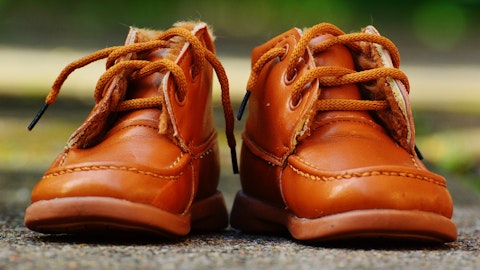Marc Maurer: Thank you for the question. So by the end of this year, we’ll be roughly — in roughly around 10,000 doors globally. In fall/winter ‘23, we’ve basically added roughly 200 doors in the U.S. and 50 doors in Asia Pacific. And how you can think about this going forward or especially into 2024, that will most likely at around 8% to 10% of doors towards the — towards kind of end of 2024. Now what’s important is that the structure of the doors really differs depending on which markets we’re focusing on, right? So we have pretty clear visibility in how we want to grow basically key accounts like DSG and Foot Locker and JD. At the same time, we are entering markets like Korea, where you will see doors being added, but at this lower size per door.
Cristina Fernández: And then also on the product innovation pipeline, you’ve given a lot of details around some of the launches for next year. Should we think about the pace of launches being pretty evenly spread through the year or are they more weighted to the first half versus the second half?
Caspar Coppetti: Thanks for your question. Yes, we’re trying to spread them out across the year. And of course, we want to have a good balance. We have a very, very strong innovation pipeline. But of course, we also don’t want to bring too much to the market too quickly. We want to make sure that people understand the franchises they get to know a product and they can rebuy it, and it doesn’t change too much. So we’re trying to strike that this balance, so expect a pretty balanced innovation, a number of innovation launches next year.
Operator: Your next question comes from the line of Tom Nikic of Wedbush.
Tom Nikic: To follow up on Cristina’s question, Hoka talked about going into some new wholesale doors in North America in early 2024. Presumably, they’re talking about more Dick’s, Foot Locker, JD locations. Can you give us an update as to how many doors you’re in for those retailers? And how we should think about the pace of entering more doors with Dick’s, Foot Locker and JD?
Marc Maurer: Yes. Very happy to do so. Now you need to be fast in writing it down. So in Q3, we had 200 Foot Locker doors in the U.S. and 110 in EMEA. DSG, we were, by the end of Q3 in 170 doors, JD, 193 in the U.S. and 120, EMEA, REI, 181, Fleet Feet, 256, and Nordstrom, 94, that’s basically all the doors that those accounts have. And so expect us basically to now over the next quarters at around 25 doors per quarter with some of those accounts, especially Foot Locker, that’s a meaningful number. I think if you look at JD, it’s similar. So that’s roughly what you will see. And that will bring you kind of by the end of fall/winter to 350 doors globally for Foot, 170 doors still for DSG and then 338 doors for JD globally. So you’ll see there a bit of stronger growth as well.
Tom Nikic: Great. That’s very helpful. And if I could just follow up there. And as you’ve entered these retailers initially, how have you seen the — I guess, the consumer acceptance, the ramp-up, et cetera? Has it been similar to when you’ve seen — when you’ve opened the new door in the specialty running channel?
Marc Maurer: Yes. I think it’s — we have to distinguish the channel a bit. So DSG is really a general sporting goods channel. So where we had a lot of experience in the past as well if you take an account like SportChek in Germany, and we entered with shop-in-shops. We were entering with a big focus on apparel as well. And the openings have all been super, super strong. Foot Locker and JD have — was really speaking to a different consumer as well. So it was a slightly new channel for us. We were very prudent in how we entered. And what we do with both of them is definitely creating a big focus around introducing the brand to their consumers through marketing but also really focusing on the right silhouettes. And when we take a product like the Cloudnova, that is doing extremely well in both channels, and they’ve been absolutely crucial to building that product.
And when you look at JD in Europe, for example, it’s our strongest partner on the apparel side. So they’re really, really helpful in building some of our key franchises, and we’re very happy in how the introductions have worked out.
Tom Nikic: Great. And best of luck this upcoming holiday season.
Operator: Your next question comes from the line of Michael Binetti of Evercore ISI.
Michael Binetti: Let me add my congrats on the marathon, awesome win for you guys. I just want to follow up on one of the modeling questions earlier. How should we — the gross margin being potentially conservative in the fourth quarter. You’ve had a couple of quarters now over 59%, getting pretty close to 60%, and you have a bigger impact from D2C in the fourth quarter. Can you just tell us where in the underlying business, you assumed conservatism in the fourth quarter gross margin? Is there a channel or a region in the quarter that you guys were looking at that could disrupt that historical mix shift benefit you get from D2C being 500 basis point or 600 basis point higher mix in fourth quarter this year versus last year?
Also in fourth quarter, I think direct-to-consumer implies like a low-40s growth rate, a little bit below the third quarter. Just any reason you think for that deceleration? Is that something you’re seeing currently or is it just conservatism as well? And then I think the bigger picture question is one of your biggest competitors is re-approaching the wholesale channel over the next year, Nike, it pulled back a bit over the last 2 years. And I think some of the indications that part of that push will happen in channels where you guys are obviously very competitive. As you speak to retailers in those channels, do you have any idea out there thinking approaching changes to the planogram or to the shelf space matrix as one of their bigger brands is presumably going to be taking up some more space than they have in the past few years?




